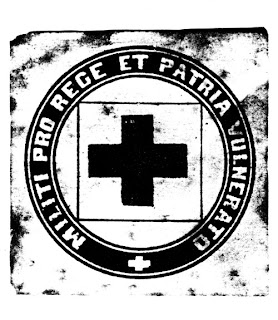A creative collection and active documentation of ephemeral objects, words, pictures, images and ideas by visual artist, writer, and poet Jerome Page Tobias.
Thursday, June 17, 2010
Monday, June 14, 2010
International Red Cross Seals
Fig. 12.1 Spain, 1870–1878.
Fig. 12.4 Spain, 1959.
Fig. 13.2 Hungary, 1870–1878.
Fig. 13.7 Portugal, 1870.
Fig. 12.2 Serbia, 1870–1878.
Fig. 13.8 Mecklenburg, 1870.
Fig. 12.3 Germany, 1870.
Fig. 13.1 Italy, 1864.
Fig. 13.4 Spain, 1870–1878.
Fig. 13.9 Serbia, 1870.
Fig 12.6 Russia, 1870–1878.
Fig. 13.3 Austria, 1870–1878.
Fig. 13.5 Vietnam, 1959.
Fig. 13.6 Indonesia, 1965.
Fig 12.5 Venezuela, 1959.
Labels:
Historical Survey,
International Seals,
red cross
Safety First
The premise that every private collection revolves around the collector and not the things s/he collects. Ultimately, a collection mirrors the taste, ideas, and desires of the compiler. This collection purposefully focused and narrowed to a current collection of the Swiss Cross, and its connection to instructional safety manuals. The origins of inspiration and motivation reflect on early interest on instructional imagery from early childhood Boy Scout handbooks.
The International Red Cross agency formed in consequence by the Geneva Convention (1864) to assist those wounded or captured in war, secure neutrality of nurses, hospitals, etc., and help relieve suffering caused by pestilence, floods, fires, and other calamities. There are national branches; the British Red Cross performs relief duties throughout the world; the American Red Cross also runs a blood supply service. All branches use the symbol of the red cross on a white ground, except Muslim branches, which use the red crescent, Israel, which uses a red Star of David, and Iran, which uses a red lion and sun. Red Cross, international organization has concerned itself with the alleviation of human suffering and the promotion of public health; the world-recognized symbols of mercy and absolute neutrality are the Red Cross, the Red Crescent, and the Red Crystal flags and emblems. The historical nature of the safety and service mark are void of its association with Christian hospitals and medical institutions. National health and safety seals embedded the geometric Greek cross often in stark contrast to geometric nature of international cross symbol.
Safety First looks to recognize the visual connection of The American Red Cross publications, insurance safety manuals, and medical kits offered to encourage safety procedures in the home, office, and work place. Embracing the inspiring publications and objects’ history is continually further from the authoritative source for which the service mark received its recognition and meaning. The geometric and abstract nature of the Swiss Cross has been subject to further disassociation, significance, and meaning. Contemporary artifacts use implied meaning and former recognition, turning this international symbol into a blind abstraction.
Aside form the cross itself, historical use of imagery across multiple handbooks remains intriguing. Crucial procedural information, depicted in even weight vignettes, has a sterile and controlled appearance. Consistently both the victim and rescuer depicted as males reveal tender embrace. Imagery of participating women is often restricted to married mothers directing aid upon their children.
The emblematic Red Cross is limited to official National and American Red Cross associations generating numerous manuals and products consisting of; First Aid textbooks, lifesaving manuals, blood donor recognition items, and medical and safety implements. First aid medical kits and manuals most frequently published and provided by insurance or medical supply companies represent the majority and lack the official Red Cross demarcation accordingly.
Fig. 1
First Aid
Metropolitan Life Insurance Company Press
New York, U.S.A.
Date Unknown
5.325” x 7.625”
Metropolitan Life Insurance Company Press
New York, U.S.A.
Date Unknown
5.325” x 7.625”

Fig. 2
Standard First Aid and Personal Safety
The American National Red Cross
Washington D.C.
©1973
5.5” x 8.5"
 Fig. 3
Fig. 3Lifesaving:Rescue and Water Safety
The American National Red Cross
Washington D.C.
©1974
5.5” x 8.5”
First Aid: Merit Badge Series
Carl J. Potthoff, M.D.
Boy Scouts of America
New Brunswick, NJ
1966
5.325” x 8”
Carl J. Potthoff, M.D.
Boy Scouts of America
New Brunswick, NJ
1966
5.325” x 8”
Fig. 6
First-aid
Metropolitan Life Insurance Company Press
New York, NY
June 1952
5.25” x 7.75”
First-aid
Metropolitan Life Insurance Company Press
New York, NY
June 1952
5.25” x 7.75”
Fig. 7
First Aid Textbook
The American National Red Cross
Washington D.C.
©1945
5.25” x 7.75”
Fig. 8
Swimming and Lifesaving
Metropolitan Life Insurance Company Press
New York, NY
Date Unknown
5.25” x 7.75”
Swimming and Lifesaving
Metropolitan Life Insurance Company Press
New York, NY
Date Unknown
5.25” x 7.75”
Fig. 9
First Aid Textbook
The American National Red Cross
Washington D.C.
©1957
5.25” x 7.75”
First Aid Textbook
The American National Red Cross
Washington D.C.
©1957
5.25” x 7.75”
Fig. 10
Safety Begins at Home
Metropolitan Life Insurance Company Press
New York, NY
July 1951
5.325” x 7.75”
Metropolitan Life Insurance Company Press
New York, NY
July 1951
5.325” x 7.75”
Fig. 11
Help Your Child toSafetyMetropolitan Life Insurance Company Press
New York, NY
July 1950
5.325” x 7.75”
Labels:
first aid manuals,
red cross,
safety first
Role of the Collector
From FRAME #51
Anneke BokernA show that focused on the role of the collector...
The premise that every private collection revolves around the collector and not the things s/he collects. Ultimately, a collection mirrors the taste, ideas and desires of the compiler. Most collections, however, never reach the stage of completion. Collecting is a mind game, fueled by fantasies about future acquisitions.
—in other words, an installation for each visitor’s imaginary collection
Subscribe to:
Posts (Atom)















































